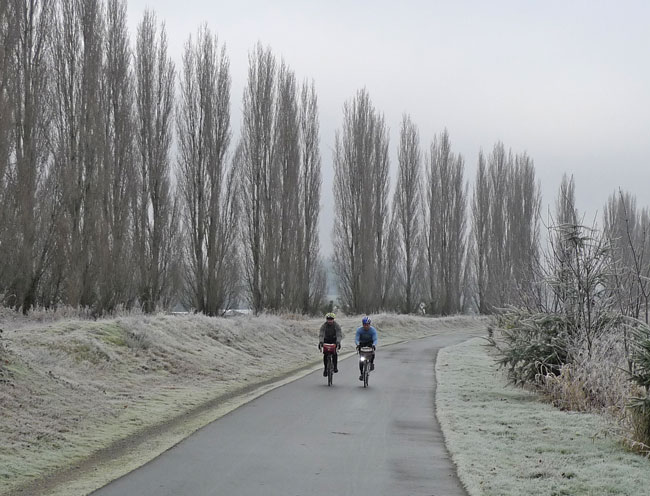Posted by: Jan Heine
Post Date: 15 Jan 2013
Staying Warm

Winter is a great time for riding around here. We have a choice between cold and sunny or not-so-cold and rainy. If we can, we pick the sunshine, but that often means starting our rides when it is just below freezing.
Riding into a glorious winter morning is wonderful, if you are warm. But if your feet and hands are blocks of ice, it’s hard to admire even the most gorgeous sunrise. Here are a few pointers toward staying warm:
- Wear insulating, breathable clothing. Getting hot and sweaty is a recipe for getting cold and clammy on the next downhill. That is why I avoid shells and instead layer up with wool. Wool is a favorite around here, because it adjusts to a variety of temperatures. If you don’t have a wool jersey, an old wool sweater will do just fine. If it’s very cold, a shell can be useful to block the wind, but remember to take it off before you get sweaty inside.
- Think of your core as the origin of your body’s warmth. If your core becomes cold, you will notice it first in your feet and hands. Putting on warmer gloves and shoe covers won’t help, because there isn’t enough heat coming from your core. Instead, cover up your torso, arms and legs. Think of your extremities as radiators for the excess heat your body generates when you ride.
- If you get cold, pedal harder. It’s that simple: the more calories you burn, the warmer you get.
- Avoid long downhills: too much air rushing by to cool you, not enough energy expended to keep you warm.
- Hot drinks. If you do get cold, you can jump-start the warming of your core by ingesting warm drinks. In the 1950s, randonneurs carried thermos on their bikes during PBP, filled with soup. On very cold days, I sometimes carry a small thermos with tea in my handlebar bag. Or we stop at a café.
- Eat. You need calories to burn. If you bonk, you’ll get cold. The time to lose weight (if that is your goal) is after the ride, when your metabolism is going strong, but you are no longer pedaling.
- On rainy days, avoid getting the spray from your tires onto your feet. Flowing water is one of the most efficient ways of cooling things. That is why most car engines are water-cooled, and so are power plants. You don’t need that for your feet. Consider installing a cut-down rear fender at the front if your fender ends more than 15 cm (6″) above the ground.
Those are the things that have helped me enjoy riding in the winter, when getting out is crucial not just for my training, but for my sanity. What are your cold-weather riding tips?


